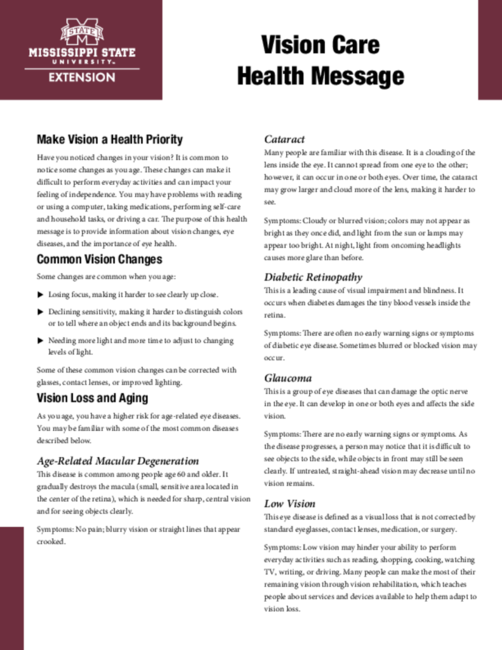P3875
Vision Care Health Message
Make Vision a Health Priority
Have you noticed changes in your vision? It is common to notice some changes as you age. These changes can make it difficult to perform everyday activities and can impact your feeling of independence. You may have problems with reading or using a computer, taking medications, performing self-care and household tasks, or driving a car. The purpose of this health message is to provide information about vision changes, eye diseases, and the importance of eye health.
Common Vision Changes
Some changes are common when you age:
- Losing focus, making it harder to see clearly up close.
- Declining sensitivity, making it harder to distinguish colors or to tell where an object ends and its background begins.
- Needing more light and more time to adjust to changing levels of light.
Some of these common vision changes can be corrected with glasses, contact lenses, or improved lighting.
Vision Loss and Aging
As you age, you have a higher risk for age-related eye diseases. You may be familiar with some of the most common diseases described below.
Age-Related Macular Degeneration
This disease is common among people age 60 and older. It gradually destroys the macula (small, sensitive area located in the center of the retina), which is needed for sharp, central vision and for seeing objects clearly.
Symptoms: No pain; blurry vision or straight lines that appear crooked.
Cataract
Many people are familiar with this disease. It is a clouding of the lens inside the eye. It cannot spread from one eye to the other; however, it can occur in one or both eyes. Over time, the cataract may grow larger and cloud more of the lens, making it harder to see.
Symptoms: Cloudy or blurred vision; colors may not appear as bright as they once did, and light from the sun or lamps may appear too bright. At night, light from oncoming headlights causes more glare than before.
Diabetic Retinopathy
This is a leading cause of visual impairment and blindness. It occurs when diabetes damages the tiny blood vessels inside the retina.
Symptoms: There are often no early warning signs or symptoms of diabetic eye disease. Sometimes blurred or blocked vision may occur.
Glaucoma
This is a group of eye diseases that can damage the optic nerve in the eye. It can develop in one or both eyes and affects the side vision.
Symptoms: There are no early warning signs or symptoms. As the disease progresses, a person may notice that it is difficult to see objects to the side, while objects in front may still be seen clearly. If untreated, straight-ahead vision may decrease until no vision remains.
Low Vision
This eye disease is defined as a visual loss that is not corrected by standard eyeglasses, contact lenses, medication, or surgery.
Symptoms: Low vision may hinder your ability to perform everyday activities such as reading, shopping, cooking, watching TV, writing, or driving. Many people can make the most of their remaining vision through vision rehabilitation, which teaches people about services and devices available to help them adapt to vision loss.
A comprehensive dilated eye exam can help spot age-related eye diseases in their early stages. It can also spot other common vision problems for which you might need glasses or contact lenses. Everyone 50 or older should have a comprehensive dilated eye exam. This exam involves dilating the pupil and is used to determine if your vision is normal and if your eyes are healthy. The retina and optic nerve are examined for signs of disease. Your vision may be blurred for several hours after the exam. Your eye doctor will tell you how often you need the exam depending on your specific eye health needs. An ophthalmologist (specialized physician) or optometrist can perform this eye exam.
Protect Your Vision
These are some additional things you can do to protect your vision:
- Do not smoke.
- Eat a diet with lots of leafy, green vegetables and fish.
- Discuss taking vitamins and supplements for your eyes with your physician or eye doctor.
- Be physically active every day.
- Maintain normal blood pressure.
- Control diabetes (if you have it).
- Wear protective eyewear when working around your house or playing sports.
- Wear sunglasses and a brimmed hat.
Questions to Ask Your Eye Doctor
Have a list of questions and concerns ready when you visit your doctor. Below are some questions you might want to consider asking:
- Am I at higher risk for eye disease?
- What changes can I expect in my vision?
- Will the changes in my vision get worse?
- Can the changes in my vision be corrected? How?
- What can I do to protect my vision?
- Will diet, exercise, or other lifestyle changes help?
Take-Home Message
- Make your vision a health priority!
- Some vision changes are normal as you age.
- Visit your eye doctor for a comprehensive dilated eye exam.
- Don’t be afraid to ask your eye doctor questions.
- Inform your eye doctor of all medications and supplements you are taking.
More information is available. Visit the National Eye Institute’s page on healthy eyes at https://www.nei.nih.gov/learn-about-eye-health/healthy-vision, or call (301) 496-5248 to speak with a representative at the National Eye Institute.
Publication 3875 (POD-01-23)
By Ann Sansing, Extension Instructor, and Bonnie Carew, PhD, former Rural Health Program Leader, Food Science, Nutrition, and Health Promotion.
The Mississippi State University Extension Service is working to ensure all web content is accessible to all users. If you need assistance accessing any of our content, please email the webteam or call 662-325-2262.
